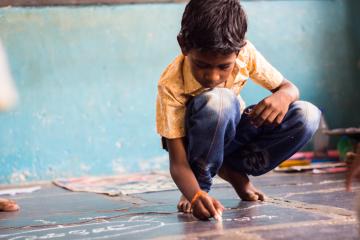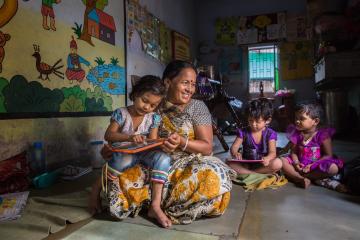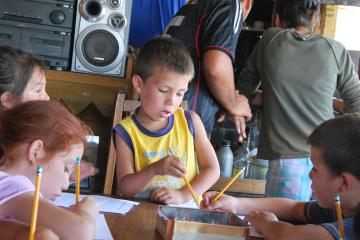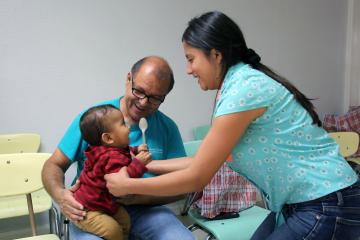
A child’s earliest years shape lifelong outcomes. To boost children’s development, invest in programs that help parents interact with babies and toddlers in stimulating ways.
Invest in babies’ development through early childhood stimulation programs. When parents play, sing, and read with their babies, it lays the foundation for brighter futures as babies learn to think, communicate, and connect with others. Policymakers should invest in programs that support caregivers to provide more stimulating care for their children.

Prioritize children with the greatest needs. Children from low-income, disadvantaged households can make the largest improvements from early childhood stimulation programs, and they earn more thirty years later.
Test different delivery models at scale. While the impact of ECS on children can be transformative, more research is needed to find a delivery approach that is scalable and consistently effective.
From birth to age three, children experience a critical window of development that shapes how they learn, behave, and interact with others. These early years lay a foundation for children’s education, health, and even the jobs they will hold as adults. Yet signs of inequality also appear in early childhood: While 78 percent of young children in wealthy households meet key developmental milestones, only 55 percent of those from low-income households are on track. This gap threatens to reinforce cycles of poverty and limit the potential of millions of children before they even enroll in school.
Every parent knows they should feed, clothe, and shelter their baby, but fewer realize something just as important: Babies need caregivers to engage their brains. Early childhood stimulation (ECS) is simple and effective in building infants’ and toddlers’ cognitive, language, social, and motor skills. Encouraging caregivers to read, sing, and play with their children supports both cognitive and psychosocial development. Children facing disadvantages like stunted growth, undernutrition, or low early cognition can benefit the most from ECS programs.
Mobilizing volunteers or community health workers to share ECS knowledge and resources through home visits or group sessions can help parents build skills and confidence. These interactions empower parents to provide more frequent and higher-quality play at home. Existing home visitation programs, health clinics, and community centers offer entry points to reach families with ECS services.
Investing in ECS programs gives children the head start they need to break the cycle of poverty. A landmark study in Jamaica tracked participants into their early 30s and found that early stimulation led to higher academic achievement, stronger employment outcomes, and greater adult earnings.

"I tracked the development of 300 children born in Kingston. These were children I knew… I saw them regularly in the hospital during their infant check-ups. Their development had been fine when they were babies, but not when they were toddlers, and they had deteriorated. When I went to their homes, I saw that they weren’t getting the right stimulation."
—Sally Grantham-McGregor, primary researcher behind a flagship study on early childhood stimulation (ECS) in Jamaica, on what sparked her interest in ECS.
Cost and design considerations
ECS programs work by improving children’s home environments. This can be achieved in different ways. Families have received ECS programs during clinic visits, home visits, and group sessions, delivered through community health workers, educators, and leaders. ECS programs primarily offer parents counseling and usually include resources such as nutritional supplements, books, toys, or cash transfers.
Leveraging existing government program infrastructure is needed to achieve scale and lower costs. Different models of ECS programs range from US$134 to $500 per child per year—close to the typical cost for early childhood care and education programs in LMICs, around US$289. Lower-cost programs typically leverage existing infrastructure, and costs vary based on program duration, program delivery, and the use of technology. Policymakers should weigh the tradeoffs of different delivery models, including reach and accessibility, to choose the most cost-effective approach for their context.
Achieving lasting impacts at scale means staying engaged with children and their caregivers. Research on ECS programs shows that children’s cognitive gains may fade if parents stop receiving support to maintain a stimulating home environment. Research shows that scaled-up models did not improve children’s development because the programs did not sufficiently meet parents’ needs. In some cases, however, the benefits of ECS programs may emerge only later in life. We need more medium- and long-term studies to capture a fuller picture of what children can achieve with stimulating care.
Achieving lasting impacts at scale means staying engaged with children and their caregivers.
Implementing partners
Implementers bring deep local knowledge, technical expertise, and a commitment to evaluation and learning as they bring these programs to life. Non-governmental organizations that, to the best of our knowledge, integrate these lessons into their programming include the following (listed in alphabetical order); this list is not exhaustive.
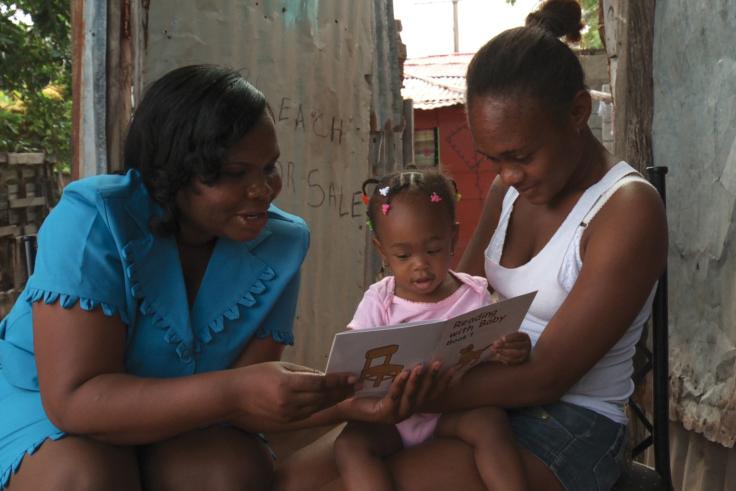
The role of low- and middle-income country governments
Governments have incorporated ECS programs into existing national family welfare programs to facilitate efficient scale-up. In Colombia, for example, the National Planning Department (Departamento Nacional de Planeación) embedded ECS and nutrition support into Familias en Acción, a conditional cash transfer program. This approach leveraged influential “mother leaders” as local liaisons who connected families to program resources and delivered ECS interventions. Although there were limited resources to implement the ECS program as intended and measure long-run outcomes, children showed gains in cognitive and language development.
In Bangladesh, the National Nutrition Service (NNS) partnered with Save the Children to deliver ECS services to 18,000 young children, leveraging NNS community health workers. The program helped children improve their cognitive, language, socio-emotional, and physical development. At a cost of less than US$10 per child, the program achieved outcomes comparable to smaller, more expensive ECS programs in other contexts.
The role of foreign assistance and philanthropy
Funders and NGOs play a key role in testing innovative ECS models. The World Bank’s Strategic Impact Evaluation Fund (SIEF), for example, financed randomized evaluations of ECS parenting programs in at least seven countries that advanced both the evidence on ECS and outcomes for thousands of children. In Guatemala, investment from the IDC Network supports PROSA, a collaboration between J-PAL and Universidad del Valle de Guatemala, to test innovative early childhood development programs with public and private partners.
Research funding builds the foundation for government-led ECS programming. For instance, the SIEF-supported Jamaica study informed the Reach Up and Learn model, which has since been adopted in Bangladesh, Brazil, Guatemala, and India. Recently, the Government of Indonesia partnered with J-PAL to adapt Reach Up into a scalable, group-based format that engages both mothers and fathers.
Discover more from J-PAL
Access to childcare to improve women’s economic empowerment
PROSA: Fostering Early Childhood Development in Guatemala
Discover more from other sources
Nurturing care for early childhood development
World Health Organization
The Impacts of Childcare Interventions on Children’s Outcomes in Low- and Middle-Income Countries: A Systematic Review
Center for Global Development
Early Stimulation: Supporting Parents to Help Their Children Thrive
World Bank
Photos:
(1) A woman reading to her son in South Africa. Credit: Shutterstock.com
(2) A community health worker reads with a mother and her child in Jamaica. Credit: Development Media International
